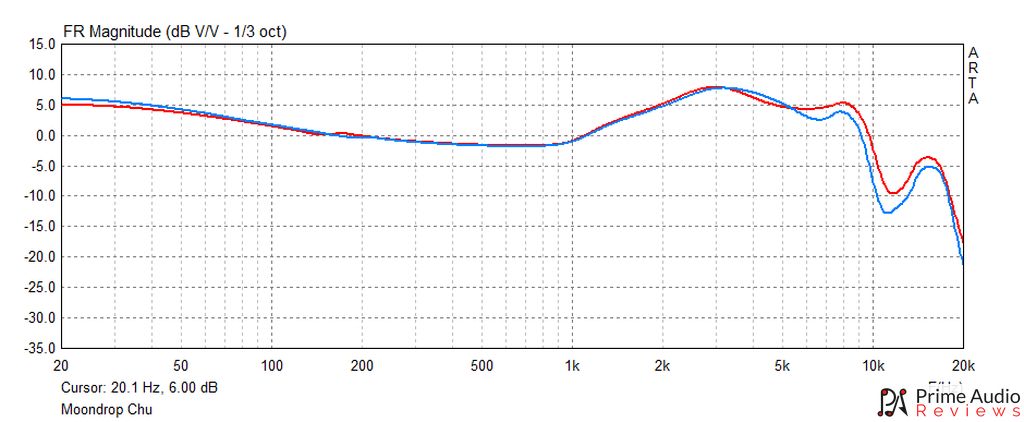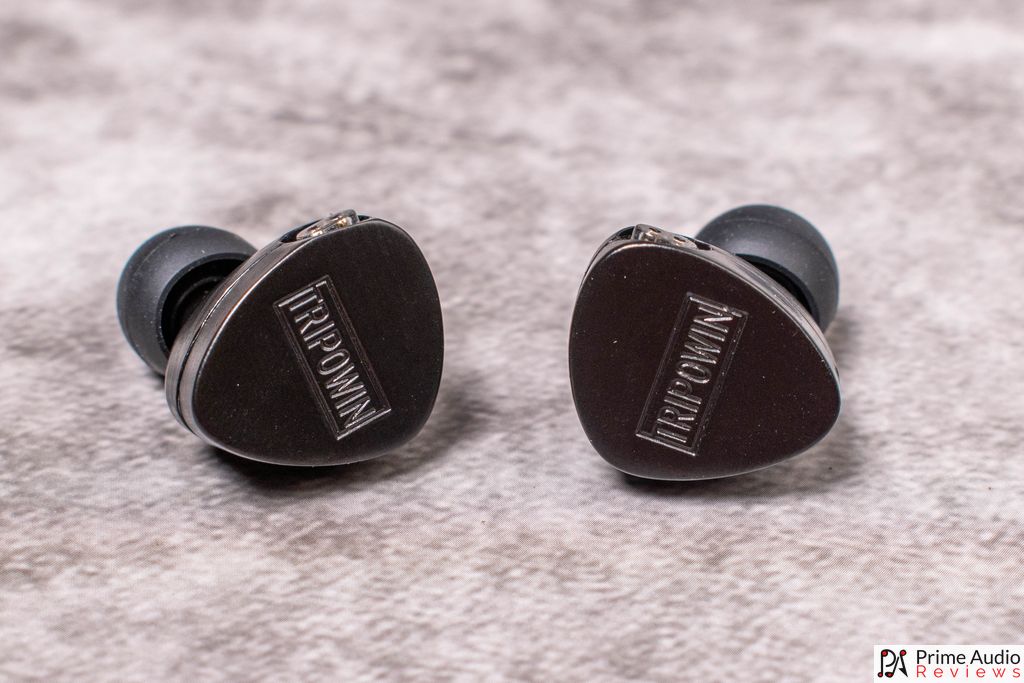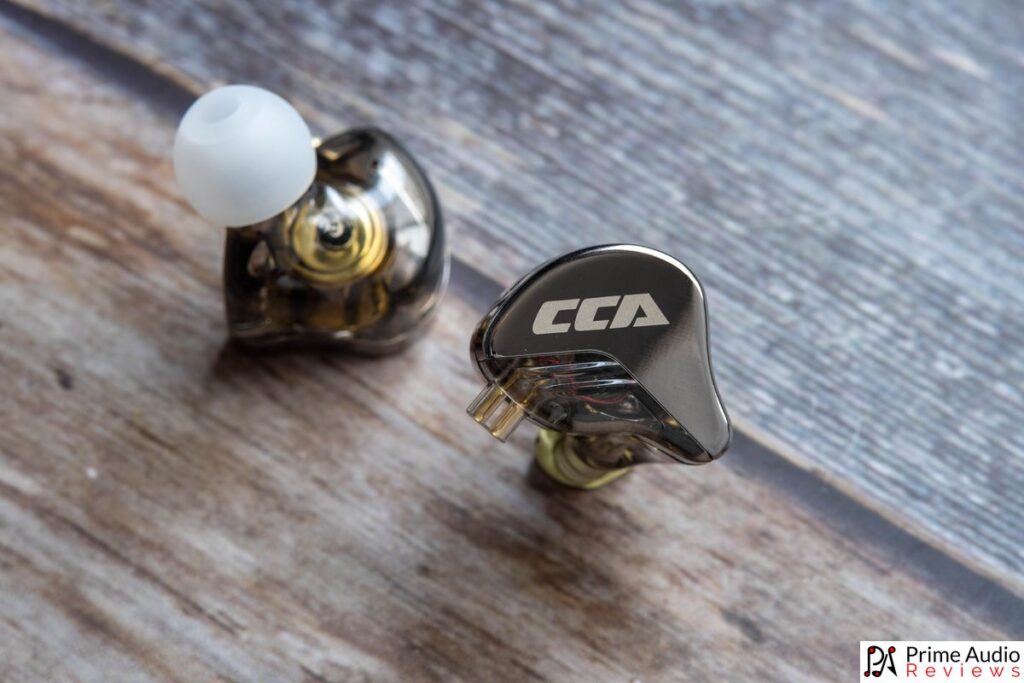In this Moondrop Chu review, I’m looking at the latest single dynamic driver earphone from Moondrop. The Chu has metal shells and is priced at $20.
Disclaimer: This sample was provided by Shenzhen Audio for the purpose of an honest review. All observations and opinions here are my own based on my experience with the product.
Moondrop Chu
Specifications
- Material | Zinc alloy
- Driver | 10mm high-performance dynamic driver
- Diaphragm material | Titanium-coated
- Magnetic circuit | N52 neodymium magnetic
- Acoustic filter | Patented anti-blocking (anti-imbalanced) acoustic filter
- Sensitivity | 120dB/Vrms(@1KHz)
- Impedance | 28 Ω 土15% (@1khz)
- THD | THD@1KHz≤1%
- Frequency range | 10Hz 35kHz (IEC61094, Free Field)
- Price | $20


Package and Accessories
The Chu comes in a small no-fuss box with a colourful waifu illustration on the front. On the back of the box are a frequency response graph and a list of specifications. Inside, you’ll find the Moondrop Chu earphones, 3x pairs of Moondrop Spring silicone eartips and a small carrying pouch.

Design
The Chu shells are small – smaller than they look in photos. in fact, they’re only about half the size of the Moondrop Aria. Crafted from zinc alloy, the shells feel solid and really well built. They have a smooth black finish and are free from embellishment apart from a small gold-coloured pattern on the faceplates that looks like a bamboo leaf.
There are 2 small vents on the inner side of the housings and the nozzle has a lip plus a protective metal mesh. The mesh helps to prevent ear wax and debris from getting inside the shells.

Chu has a fixed cable which is unfortunate but one can hardly complain at this price point. The cable is rubbery, bouncy and suffers from microphonics but again – that price.
One thing I was not expecting is how comfortable Chu is in my ears. The small shells fit naturally and the angled nozzles are just the right length. You can easily lie down with these IEMs because they have a low profile and don’t protrude out from your ears.
Sound
Gear used for testing includes the iFi Micro iDSD Signature, Moondrop Moonriver 2 and Shanling M5s.
Would you be surprised if I told you that Chu was tuned to the Virtual Diffuse Sound Field (VDSF) target? Probably not. That’s what Moondrop does and people love it so I guess if it ain’t broke, don’t fix it.
For the uninitiated, the VDSF is a frequency response modelled on the Harman target. It’s fairly neutral with an upper midrange and lower treble focus. This is topped off with a neutral bass and rolled off upper treble and is the classic Moondrop house sound.
Chu’s presentation is clear, detailed and neutral/bright. It has levels of resolution and detail retrieval that aren’t common in ultra-budget IEMs. The Chu is easy to drive and works fine straight out of a phone or basic dongle DAC. It doesn’t require extra amplification or a fancy/expensive source.

Bass
Bumped up slightly above neutral, the Chu’s bass is reserved in quantity. However, the quality of the bass is outstanding for a budget IEM. Bass notes have great definition with clean leading edges and controlled decay.
There’s an emphasis on the sub-bass which feels confident but restrained – bassheads need not apply here. The lower bass is nicely weighted but mid and upper bass notes lack power. There’s an upside, of course, and it is the airiness of the bass which comes from the driver’s speed and is further enhanced by the treble tuning.
It’s a non-destructive bass that doesn’t infringe on the midrange, aiding in Chu’s overall resolution. However, there is a slight lack of body and rhythm which is a common characteristic of this type of bass tuning.

Midrange
The midrange exudes clarity and detail. It’s a neutral midrange but one with enough body and robustness to sound mainly natural. It could use a touch of added warmth but instead aims for more transparency and articulation.
The Chu’s midrange is characterized by its lifted upper-mid bands, resulting in a brighter more energetic tone. There’s abundant presence and vibrance in female vocals but male vocals sometimes lack richness. That said, Chu has an energetic and clean vocal presentation.
Instruments sound clean and have a fairly accurate timbre. However, some instruments in the upper registers eg. pianos and brass instruments sound forward and bright. Fans of John Coltrane or Miles Davis might find the Chu fatiguing if they’re sensitive to upper-mid and lower treble frequencies but will certainly appreciate the clarity. Listening to John Coltrane’s “My Little Brown Book”, the piano sounds a little thin and the saxophone sounds a bit sharp but both are brimming with energy.
Treble
Chu’s lower treble is key to its overall presentation and tonality. Hi-hats sparkle and percussion instruments have stark definition and contrast. Treble notes are slightly rounded and sweet with a good amount of trailing air.
The mid-treble dips to maintain timbre then lifts again in the upper range. This too, adds to the Chu’s airiness and the well-extended highs facilitate ample detail retrieval. It’s a fairly precise treble with good resolution that is both exciting and tolerable.
Soundstage and Technicalities
The soundstage is fairly intimate on the Chu due to a forward stage position. This puts you up close to vocals but there’s sufficient space around the centre image to avoid feeling confined. Imaging is quite strong and Chu gives good positional cues, making it easy to place instruments in the virtual space. Clarity and detail retrieval are both very good and overall this IEM has a strong technical performance for something in this price range.
Comparisons

Tripowin Lea ($25)

The Tripowin Lea (review here) is a single dynamic driver IEM. These 2 IEMs share a very similar frequency curve, as you can see in the graph above. Both models have lean, quick lows that favour the sub-bass over the mid-bass. Lea’s bass is a little drier and less rounded whereas Chu’s lows have more body and resonance.
The Lea and Chu both have a neutral midrange with good separation from the bass and reduced saturation. This leaner tuning gives them good midrange detail and a clean sound but I find Chu’s overall resolution to be a tad better.
I feel the treble is Lea’s weakest element and it becomes more apparent when comparing directly to the Chu. Leas’ treble sounds drier and a bit scratchy compared to Chu’s rounder, sweeter highs. Lea’s treble notes are more metallic and have a less accurate timbre.
The Tripowin Lea has a slightly larger soundstage with a more neutral stage position (Chu’s stage is closer to the listener) but the Chu’s increased resolution gives it a blacker background and stronger imaging.

CCA CRA ($14)

The CCA CRA (review here) is a single dynamic driver IEM. It’s more V-shaped than the Chu courtesy of its enhanced bass and mid-treble. The CRA has more bass quantity, giving it a warmer foundation, more bass impact and sub-bass rumble.
As a result of its elevated bass, CRA’s midrange is more recessed than the Chu’s but has more body and warmth inherited from the bass. But the CRA also has a more uneven treble and a prominent 8kHz peak that can sizzle at times.
The Chu’s treble is more even and not as sharp as the CRA. Chu relies more on its upper midrange and lower treble for clarity and brightness. It does this with sweeter, rounder treble notes and a more accurate timbre than the CRA.
CRA’s soundstage is wider and deeper but the Chu’s extra resolution and blacker background give it the edge in imaging and instrument separation.

Verdict
Well, I feel like I’m starting to sound like a broken record each time I review a Moondrop earphone. The brand keeps refining its house sound and is continually pushing prices down. The Moondrop Chu is probably the best neutral-tuned sub $20 IEM you can buy right now. So it should come as no surprise that this one gets the PAR recommended award and a spot on our best IEMs list.



